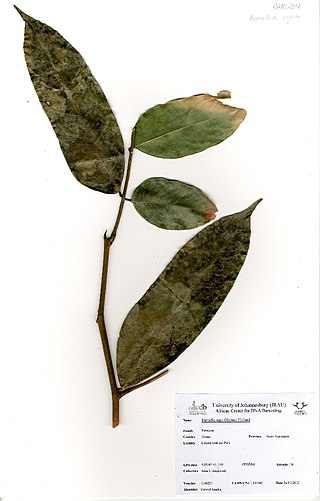
Afzelia is a genus of plants in family Fabaceae. The thirteen species all are trees, native to tropical Africa or Asia.

Cynometra is genus of tropical forest trees with a pantropical distribution.

The subfamily Detarioideae is one of the subdivisions of the plant family Fabaceae (legumes). This subfamily includes many tropical trees, some of which are used for timber or have ecological importance. The subfamily consists of 84 genera, most of which are native to Africa and Asia. Pride of Burma and tamarind are two of the most notable species in Detarioideae. It has the following clade-based definition:
The most inclusive crown clade containing Goniorrhachis marginataTaub. and Aphanocalyx cynometroidesOliv., but not Cercis canadensisL., Duparquetia orchidaceaBaill., or Bobgunnia fistuloides(Harms) J. H. Kirkbr. & Wiersema.

Anthonotha is a genus within the subfamily Detarioideae of the plant family Fabaceae.

Berlinia is a genus of flowering plants in the family Fabaceae. It includes 21 species of trees native to sub-Saharan Africa, ranging from Guinea to Chad, Tanzania, Mozambique, and Angola.

Cryptosepalum is a genus of flowering plants in the family Fabaceae. There are 12 species, mostly trees. They are native to sub-Saharan Africa, ranging from Guinea to Tanzania, Mozambique, and Angola.

Daniellia is a genus of plants in the family Fabaceae, named after William Freeman Daniell. It includes ten species native to sub-Saharan Africa, ranging from Senegal to Sudan and south to Zambia and Angola.

Didelotia is a genus of flowering plants in the family Fabaceae. It includes 13 species native to western and west-central tropical Africa, ranging from Sierra Leone to the Democratic Republic of the Congo.
Englerodendron is a small genus of legumes belonging to the family Fabaceae, that are native to tropical Africa.
Gilbertiodendron splendidum is a tall forest tree of lowland swamp forests of coastal West Africa in the family Fabaceae. It is found in Upper Guinean forests along coastal regions of Côte d'Ivoire, Ghana, and Sierra Leone. It is threatened by habitat loss.

Hymenostegia is a genus of flowering plants in the family Fabaceae. It includes 14 species native to west and west-central tropical Africa.
Talbotiella is a genus of flowering plants in the family Fabaceae. It includes 9 species native to west-central and west tropical Africa. Most species ranges from Ghana to the Republic of the Congo. Five are endemic to Cameroon. T. cheekii is endemic to Guinea.
Tessmannia is a genus of flowering plants in the family Fabaceae.

Trichoscypha is a genus of plants in the family Anacardiaceae. It includes 32 species native to tropical Africa.
Aphanocalyx is a genus of flowering plants in the family Fabaceae. It belongs to the subfamily Detarioideae. It includes 14 species native to tropical Africa, ranging from Sierra Leone to Côte d'Ivoire, and from Cameroon to Angola and Tanzania.
Pseudoprosopis is a genus of flowering plants in the family Fabaceae. It includes seven species of shrubs, lianas, or small trees native to tropical Africa. Typical habitats include tropical rain forest, gallery forest, seasonally-dry forest, and dense thicket. Three species are native to west-central Africa, two species to West Africa, and two species to southeastern Africa – one to the Zambezian region and one to the Zanzibar–Inhambane region. The genus belongs to the mimosoid clade of subfamily Caesalpinioideae.

Prioria is a genus of flowering plants in the family Fabaceae. Members of this genus are found in Central America, Africa, southern Asia, and Oceania.

Micklethwaitia is a monotypic genus of legume in the family Fabaceae. Its only species, Micklethwaitia carvalhoi, is endemic to Mozambique. It is closely related to Annea, Gabonius, and Scorodophloeus.
Gambeya is a genus of flowering plants belonging to the family Sapotaceae.












